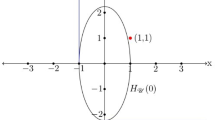Abstract
Using a short proof, we show that every set function f can be decomposed into the difference of two monotone increasing and strictly submodular functions g and h, i.e., \(f=g-h\), and every set function f can also be decomposed into the difference of two monotone increasing and strictly supermodular functions g and h, i.e., \(f=g-h\).
Similar content being viewed by others
References
Du DZ, Ko KI, Hu X (2012) Design and analysis of approximation algorithms. Springer, Berlin
Gu S, Shi G, Wu W, Lu C (2020) A fast double greedy algorithm for non-monotone DR-submodular function maximization. Discrete Math Algorithm Appl. 12(1):2050007:1–2050007:11
Guo J, Weili W (2019) A novel scene of viral marketing for complementary products. IEEE Trans Comput Soc Syst 6(4):797–808
Iyer R, Bilmes J (2012) Algorithms for approximate minimization of the difference between submodular functions. In: Proc, UAI
Lai L, Ni Q, Lu C, Huang C, Wu W (2019) Monotone submodular maximization over the bounded integer lattice with cardinality constraints. Discret Math Algorithm Appl 11(6):1950075:1–1950075:14
Li X, Du HG, Pardalos PM (2020) A variation of DS decomposition in set function optimization. J Comb Optim 40(1):36–44
Lu W, Chen W, Lakshmanan LVS (2015) From competition to complementarity: comparative influence diffusion and maximization. In: Proceedings of the VLDB endowment 9(2): 60–71
Narasimhan M, Bilmes J (2005) A submodular-supermodular procedure with applications to discriminative structure learning. In: Proc, UAI
Shuyang G, Gao C, Yang R, Weili W, Wang H, Dachuan X (2020) A general method of active friending in different diffusion models in social networks. Soc Netw Anal Min 10(1):41
Weili W, Zhang Z, Ding-Zu D (2019) Set function optimization. J Oper Res Soc China 7(2):183–193
Yang DN, Hung HJ, Lee WC, Chen W (2013) Maximizing acceptance probability for active friending in online social networks. In: KDD, pp. 713–721
Yuan J, Weili W, Yi L, Ding-Zhu D(2017) Active friending in online social networks. In: BDCAT, pp. 139–148
Zhang H, Dinh TN, Thai MT (2013) Maximizing the spread of positive influence in online social networks. In: ICDCS, pp 317–326
Acknowledgements
This work is supported in part by NSF CNS-1948550.
Author information
Authors and Affiliations
Corresponding author
Additional information
Publisher's Note
Springer Nature remains neutral with regard to jurisdictional claims in published maps and institutional affiliations.
Rights and permissions
About this article
Cite this article
Li, X., Du, H.G. A short proof for stronger version of DS decomposition in set function optimization. J Comb Optim 40, 901–906 (2020). https://doi.org/10.1007/s10878-020-00639-4
Published:
Issue Date:
DOI: https://doi.org/10.1007/s10878-020-00639-4




